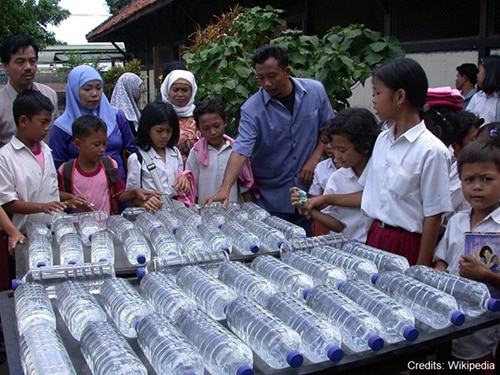With the spread of Covid-19, bird flu, and other illnesses, effective methods for disinfecting surfaces have become an important topic. Using sanitizing chemicals and boiling are commonplace, but UV disinfection is a practice that has been known for generations. People have long been putting fabrics out in the sun, letting its UV radiation remove any moldy musk. One example of this is Solar Water Disinfection (SODIS), a common practice in third-world countries, where water is sterilized by exposure to sunlight for 6 hours or more. The effectiveness of SODIS is attributable to UV radiation and the heat generated by the sun.

Figure 1: Solar Water Disinfection
How does UV disinfection work?
The photons in UV radiation pack quite a bit of energy, due to their high frequency oscillation. The energy can be calculated with Planck’s equation, or E = hv, where h is Planck’s constant (6.626 x 10-34) and v is the frequency of the photon. Bombarding an atom with these photons brings it into an excited state. UV photons, along with the free radicals that they create, can damage DNA molecules causing cells to die. This makes UV light very effective in destroying many pathogens, including viruses such as SARS-COV-2.
The Spring Effect
During the spring and summer months, the number of viral infections, such as influenza, experience large drops; this is widely known as The Spring Effect. This could be caused by several factors, including significant dilution of viruses by ventilation or wind; however, UV light most likely plays a large role. With the nicer weather, people go outdoors where the UV radiation in the sunlight is able to render pathogens and viruses inactive. The Spring Effect is a phenomena still being studied, but some of its benefits can perhaps be transferred to indoor environments and the cooler seasons using artificial lighting.
Disinfecting with Lighting
Traditionally, the standard method for disinfecting via UV light has been mercury tubes. Mercury tubes use an electric arc to produce photons from vaporized mercury, producing light, a portion of which is in the UV spectrum. Mercury has several drawbacks, however. As is widely known, mercury is highly toxic. The inhalation of mercury vapor can cause serious issues with the nervous system, digestive and immune systems, lungs and kidneys. Mercury is also non-biodegradable, presenting a problem when disposing of old bulbs. While the useful life of mercury vapor bulbs is longer than incandescent and most fluorescent bulbs, the longevity of LED light sources can be three times longer. LED light sources also use significantly less energy. Finally, mercury tubes are a very mature technology, and will most likely not see any significant advancements.
LEDs, on the other hand, are a new technology with performance that is advancing very quickly. The days where LEDs only had enough power to be indicators on electronic gear are long gone; these days LEDs are replacing most forms of lighting, and can be found in modern automobile headlights, street lamps, and heavy duty lighting fixtures in industrial environments. Additional advantages of LEDs include small form factor and better efficiency, and immediate startup without the need for warming up. LEDs can also be dimmed with PWM signals.
UV-LEDs have all the advantages of regular LEDs, while being capable of producing light in the UV spectrum. We’ll dive more into the details of UV-LEDs in part 2 of our blog.
For more information on how UV light can help fight viruses, point your browser to LEDs Go Anti-Viral from EBV Elektronik
